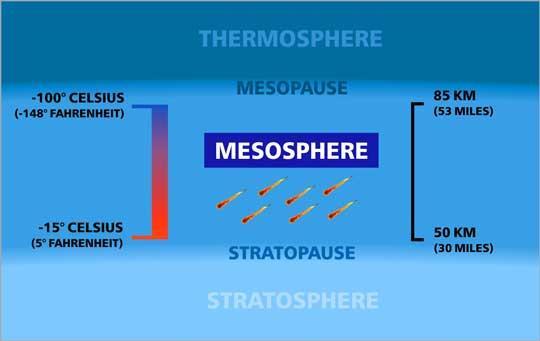Educating Facts About Mesosphere for Kids
Even though it seems like an infinite sky, Earth’s atmosphere comprises five magnificent layers, distinct from each other, namely troposphere, stratosphere, mesosphere, thermosphere, and exosphere.
There’s very little information about the mesosphere since it’s way above the limit, at which airplanes usually can fly but below the area where low-orbiting satellites operate. But sounding rockets are one option that helps investigate this atmospheric level. So here are some fascinating information and interesting and educating facts about the mesosphere.
What is the Mesosphere?
The third layer between the top layer of the stratosphere and the bottom layer of the thermosphere is the mesosphere, the coldest, nearly 85km above our planet. Most space debris and meteors get destroyed before they reach the Earth’s surface at this level.

It’s like a crusader’s force field, shielding the planet! For instance, late at night, wrapped under a blanket, you await a spectacular meteor shower. Suddenly, a streak of light appears in the sky, followed by more! But before the spectacular show ends, the flying pebbles that light up the sky vanish just like magic. It’d take 31miles for you to reach the mesosphere.
#1 Mesosphere Temperature
It has a temperature of around 85°C (120°F) and is the coldest spot on Earth. The air is so frigid just below the mesosphere that even the limited water vapor can be sublimated into polar-mesospheric clouds, which have bluish-white color.
#2 Mesosphere Altitude
The mesosphere stretches from the stratopause, about 160,000 feet above sea level, to the mesosphere, roughly 260,000–80,000 feet above sea level.
#3 What Is The Composition Of The Mesosphere?
The mesosphere encompasses oxygen, carbon dioxide, and nitrogen. The usual atmosphere we live in is 78% nitrogen and 21% oxygen, with 1% of all other substances.

Why is the Mesosphere Important?
The mesosphere is crucial for the planet’s protection, as it keeps Earth warm, shielding it from the sun’s damaging rays. It also enables a healthy balance of Oxygen and Carbon Dioxide that sustains life on our planet.
Mesosphere absorbs solar radiation with a wavelength greater than 175 nm and Lyman-alpha at 121.6 nm. Furthermore, as mentioned earlier, the mesosphere layer burns up meteors and other space debris before it reaches the Earth’s surface, preventing harmful radiations from reaching the planet.

Facts About The Mesosphere
- Mesosphere originated from the Greek words ‘Mesos’, which signifies center, and ‘sphere’ means an orb or a sphere.
- The planet’s protective blanket has seven layers: the Atmosphere, Mantle, Crust, Inner Core, Outer Core, Quantum Shell, and Nuclear Shell.
- Mesopause separates the mesosphere and thermosphere layers. Approximately 23 miles in thickness, it originates at the top of the Earth’s atmosphere and extends to its surface. It is located at the height of roughly 1,948-3,054 meters above sea level and encompasses a distance ranging from 6,000-9,500 kilometers from the Earth’s surface.
- The coldest temperature in the atmosphere, -90 degrees Celsius, can be found near the top layer of the mesosphere.
- Every day, approximately 40 tonnes of meteors collide with Earth, and when they burn, they appear like shooting stars in the night sky.
- At this level, most meteors are known to incinerate and volatilize. The radiating mesosphere contains a high iron and other metallic atoms from space debris. This function allows meteors to be destroyed before they cause harm to living things on Earth.
- Because of the extremely thin air, atoms and molecules of gases barely contact one another.
- Electrical ejections, namely sprites and elves, are two types of lighting found in the mesosphere and can be seen from a distance as thunderous clouds.
- The mesopause is the lowest point in the atmosphere, where the mesosphere shifts into the thermosphere.
- The perimeters of the mesosphere also change with the seasons: they are significantly high in the winter and lesser in the summer.
- Scientists need to use research rockets known as “sounding rockets,” more often assembled from surplus military rocket motors to explore the mesosphere.
- Also known as the ionosphere, the mesosphere is virtually untapped, more so as sounding rockets can only make short flights and cannot go around the Earth.
- At an altitude, the winds blow from north to south in the lower mesopause and east to west in the upper layer.
- The Earth is protected from space debris and meteorites by the mesosphere, which vaporizes them before reaching the Earth’s surface. Debris from space can cross the outer atmospheric levels owing to little to no air. However, there’s ample gas at the mesosphere level to produce heat that can cause them to burn.
- The mesosphere is the highest of the Earth’s atmosphere, where gases are mixed instead of layered as per their mass.
- A distinct aurora has been seen at approximately 96km above the surface in recent times. These aurorae appear like a dune. Oxygen molecules interacting with solar particles lead to green deposits.
- The mesosphere encompasses a five-kilometer sodium layer of undissolved sodium atoms, radiating delicately, leading to an airglow effect. Thanks to this faint effect, the night sky always seems somewhat lit.
- Strong east-west winds, ambient tides, internal atmospheric gravitational waves, and Earth’s waves are the most critical elements in this area. A significant proportion of these tidal currents arise in the troposphere and lower stratosphere and travel to the mesosphere.
- Gravity-wave vibrations can become so large in the mesosphere that the waves become volatile and disintegrate—this dissipation transfers acceleration to the mesosphere, which drives global circulation.

Conclusion
Although the mesosphere is the least-known layer of the atmosphere, as this article demonstrated, a significant amount of valuable information has already been accumulated to help better understand the mesosphere and its priority. The mesosphere is also considered a significant layer of the atmosphere as the other layers are.
This article explains the importance of the mesosphere and its distinct characteristics. We hope these carefully researched facts have been fascinating and fun and inspire you to find more interesting information about Earth’s atmosphere.
